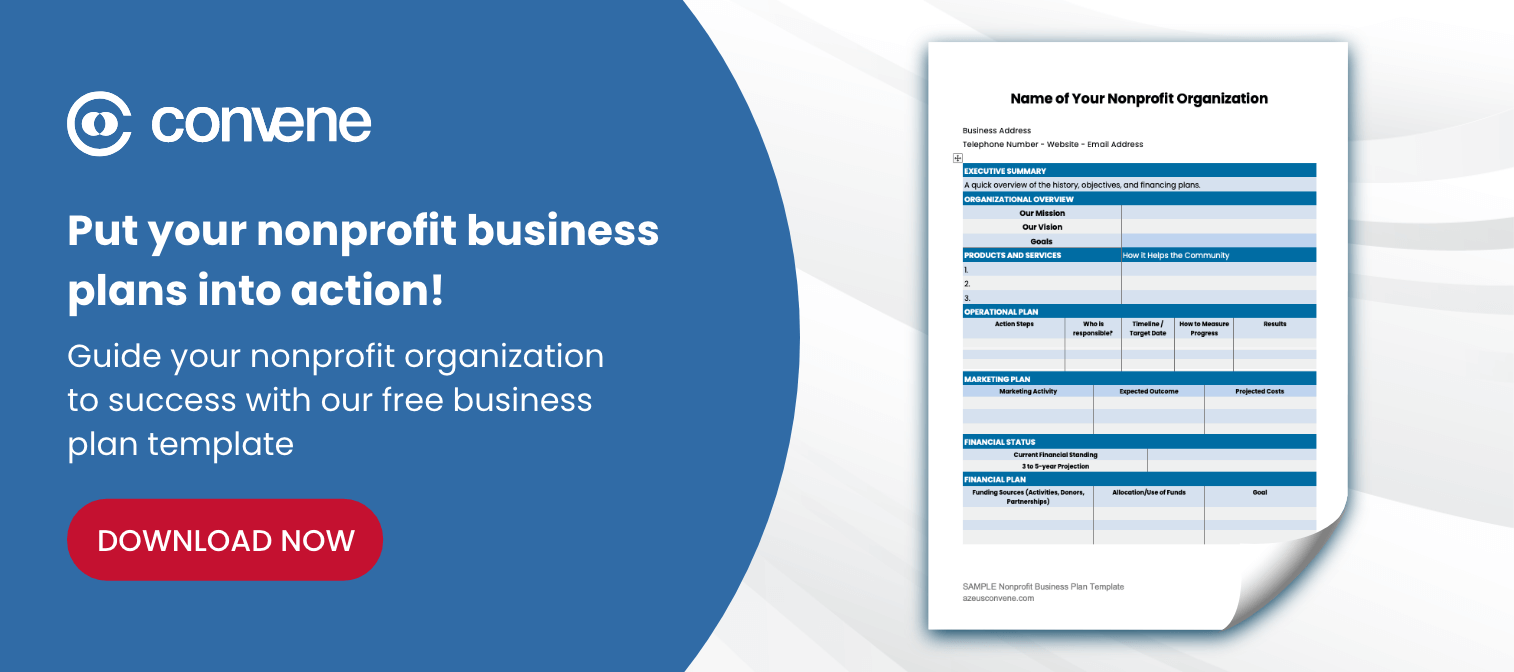Like any other business, nonprofit organizations need careful, structured planning to ensure sustainable growth. This is possible by creating a business plan that not only serves as a roadmap but also helps in attracting donors and volunteers needed to bring the organization’s vision to fruition.
Crafting the perfect business plan involves many things, but the most important part is understanding what it should look like and how it can help the organization forward its mission. This guide simplifies the process, breaks down its unique components, and provides step-by-step instructions on how to write a nonprofit business plan.
What is a business plan for nonprofits?
A business plan for nonprofits is a strategic document that outlines a nonprofit organization’s goals and operational approach. While similar to for-profit business plans, the focus here is on achieving social impact rather than financial profit.
Projects implemented by nonprofit organizations typically revolve around fostering social welfare, advocacy, education, or humanitarian aid. For instance, a nonprofit working to address homelessness might outline projects such as providing shelter and meals, offering job training programs, and collaborating with local agencies to advocate for affordable housing policies.
A typical business plan for nonprofits includes:
- The nonprofit’s mission, which sets the foundation for the entire plan;
- Specific objectives,
- Fundraising strategies,
- Resource allocation,
- And how it plans to measure success in terms of societal or community benefit.
But one thing to note is that there is no one-size-fits-all plan. Every little detail incorporated into the plan must be tailored to the organization’s needs, where it currently stands, and how it can contribute to its primary purpose – guiding the nonprofit to success.
Why Your Nonprofit Needs a Business Plan
A good plan does not only help attract external support but also benefits the organization internally. Listed below are the key reasons why your nonprofit needs a business plan:
Clarity of Mission, Vision, and Strategic Direction
Running a nonprofit organization isn’t the easiest task, and there may be times when you question whether you’re truly making an impact. Having a business plan gives you a perspective of the progress you’ve made and provides a distinct path moving forward.
This clear-cut framework ensures that the mission, vision, and strategic direction remain focused, helping the nonprofit make informed decisions and navigate challenges with purpose.
Proper Resource Planning and Financial Management
Poor financial management can lead to many problems, especially in nonprofits. With a business plan, this can easily be taken care of.
Since nonprofit organizations rely on various external funds, there should be an emphasis on resource planning and management. This involves forecasting the organization’s needs, such as financial, human, and technological resources, and strategically allocating them to support the mission and vision. Doing so also demonstrates fiscal responsibility to donors and stakeholders.
Strategic Fundraising and Sustainability
One of the most common and effective ways nonprofits gain support is through fundraising activities. A business plan helps you develop a targeted fundraising strategy that aligns with the organization’s goals. Clearly outlining the fundraising objectives, target audiences, and specific tactics provides a roadmap for effective resource mobilization.
Additionally, a structured plan attracts and retains donors by instilling confidence in them about the tangible impact their contributions can make.
Risk Management
A business plan is vital for developing strategies to handle risks and potential challenges. This proactive approach helps minimize the impact of unforeseen events, like economic recessions or natural disasters, on the nonprofit’s operations.
A robust risk management strategy not only saves time and money but also improves decision-making, avoids surprises, and, most importantly, prevents harm to the people your nonprofit serves.
Legal and Regulatory Compliance
Because the business plan already lays out how the organization works, it’s easier to understand and adhere to nonprofit laws like tax exemption and revenue regulations.
Dealing with these things from the start helps prevent potential problems, maintains transparency, and builds trust with stakeholders. This allows you to focus on carrying out the mission without legal conflicts.
How to Create a Business Plan Strategy

When gearing up to create a business plan for your nonprofit organization, it’s important to begin by thoroughly understanding the unique aspects of your mission. This solid foundation will guide you through the next steps of crafting a well-thought-out plan, which includes:
1. Create a strategy
Before anything else, you must identify your why.
Ask yourself what you want to happen. What does the organization stand for? Who does it serve? What do you hope for it to become?
If your long-term goal is to create a lasting impact and expand the community you serve, establish a strategy that mirrors your mission. Begin by assessing your organization’s current position, strengths, weaknesses, and opportunities. Based on your assessment, leverage the strengths and address weaknesses that may hinder progress.
Next, clearly define who your target audience is. Understand their specific needs and preferences to tailor your approach effectively.
Once the key factors have been determined and written down, it will serve as the starting point for the strategy.
2. Plan programs
The planning step is where you delve into the how. What are your plans to sustain and amplify the impact you aim to create?
Since you are not selling products or providing services to generate revenue, you’ll need to rely on fundraising events to support your cause. To do this effectively, create detailed program plans covering goals, activities, timelines, and expected outcomes. As always, ensure these plans align with your organization’s mission.
After establishing the programs, set up a monitoring system that tracks their effectiveness and evaluates them regularly. This helps you make informed changes as the nonprofit or the community’s needs evolve.
3. Ensure financial sustainability
Nonprofits receive financial support from various channels, such as individual donations, grants, sponsorships, and fundraising events. To ensure economic sustainability, building relationships with potential donors, individuals, institutions, and various funding sources is important to avoid relying too much on a single avenue.
In this sense, a well-thought-out budget is crucial for financial stability. Make sure to allocate resources carefully, considering program costs, administration expenses, and other needs. A clear and transparent budget not only aids in financial planning but also boosts trust with supporters.
4. Prioritize legal considerations
Even though dealing with changing rules might seem to lead to more paperwork than focusing on your mission, remember that compliance is as important as pursuing your organization’s goals. Some vital legal considerations include:
- Legal structure and registration
- Tax exemption (if applicable)
- Fundraising compliance
- Financial accountability
- Intellectual property (such as logos, trademarks, and copyrights)
- Data protection and privacy
Maintaining a good standing is crucial for obtaining licenses, securing grants and funding, protecting your organization’s reputation, and keeping the right to solicit support.
If you don’t have an in-house legal counsel, it’s a good idea to seek advice from experts who know nonprofit laws in your area when planning your business.
How to Write a Nonprofit Business Plan

Now that you’ve covered all the essential details, the next step is to create the business plan outline. There’s no strict format to follow, as it all depends on your organization’s specifics. However, make sure not to exclude these essential components when creating a nonprofit business plan:
1. Executive Summary
This part is a quick overview of the whole document. Since it’s the first thing people see in the business plan, it’s crucial to make it clear and interesting enough to grab their attention and encourage them to read the entire plan. Include the organization’s fundamentals – its history, objectives, and financing plans.
2. Organizational Overview
Provide a gist of who you are and who you serve. Here, express the organization’s mission, vision, and specific short-term and long-term goals.
3. Products, Programs, or Services Rendered
In this section, you must provide a detailed description of all the products and services mentioned in the executive summary. Highlight any unique aspects, such as innovative features and distinct advantages, that set you apart. State how instrumental these are to the success of your initiatives and how each one addresses the industry need.
4. Operational Plan
This is where you detail how your nonprofit will function on a day-to-day basis. Outline each team member’s daily, weekly, and monthly tasks, specifying responsibilities, timelines, and collaboration points to ensure a cohesive and efficient operation.
Additionally, spotlight any key processes, workflows, or systems necessary to achieve your mission.
5. Marketing Plan
The marketing plan should reflect the mission of the organization. Under this section, outline the strategies and channels to get your nonprofit out there. Include details about your target audience, methods for reaching them, and any promotional activities. This section may also cover partnerships, collaborations, and outreach efforts.
6. Financial Plan
The financial plan provides a comprehensive overview of your nonprofit’s financial health and projections. Include a budget, funding sources, and a breakdown of how funds will be allocated to support your operations and programs. This part is vital for demonstrating sustainability and helping make better-informed decisions.
7. Appendix
In the appendix, incorporate all the additional documents and information supporting the business plan’s main body. This may include resumes of key personnel, detailed financial statements, legal documents, or any other relevant materials.
Here’s a quick step-by-step guide on how to write a business plan:
- Start by outlining the executive summary providing a concise overview of the plan.
- Develop the organizational overview, which includes the mission and vision of the nonprofit.
- Conduct a SWOT (strengths, weaknesses, opportunities, threats) analysis to identify and address internal and external factors.
- Clearly articulate short-term and long-term goals and objectives.
- Describe the programs and activities that will help achieve these goals.
- Develop a marketing and outreach strategy to engage the community and attract support.
- Create a detailed financial plan, including budgets, revenue streams, and financial projections.
- Outline the governance and management structure, including roles and responsibilities.
- Detail monitoring and evaluation processes to assess program effectiveness.
Nonprofit Business Plan Template
Once you have a clear grasp of your organizational goals and strategies, here’s a sample nonprofit business plan template to get you started:
Frequently Asked Questions (FAQs) on Nonprofit Business Plan
Q: How often should a non-profit business plan be updated?
Although nonprofit plans usually set up a roadmap for at least three to five years, they should be regularly reviewed and updated to ensure they remain relevant and aligned with the organization’s purpose and changing external factors. For younger companies, an annual update with six monthly reviews may be sufficient, while more established nonprofits might opt for an annual review with quarterly check-ins.
Q: What role does evaluation play in a non-profit business plan?
Smaller nonprofits often conduct formal evaluations because their funders require it, but the benefits extend in both directions. Internally, evaluations help the organization assess its performance, impact, and effectiveness. In doing so, the nonprofit meets funder expectations and gains valuable insights for improvement, ensuring transparency and better alignment with its mission.
Q: How can a non-profit maintain adaptability in its strategies?
To stay adaptable, a nonprofit can follow three basic practices. First, keep the business plan up-to-date to align with the changing goals and environment. Second, stay on top of current industry trends to anticipate shifts in the landscape and prepare ahead of time. Lastly, revamp tools and approaches to ensure strategies remain innovative and effective.
Plan for Nonprofit Success with Convene

A well-crafted nonprofit business plan is crucial for success. To achieve this, cooperation is necessary within the internal teams and partners. However, communication can be a common roadblock, especially in a remote workplace.
This is where Convene comes into play.
Convene is a reliable board portal for nonprofits that facilitates effective planning through its interactive and secure features. Easily collaborate with everyone in the organization by leveraging Convene’s live meeting capabilities, such as annotations and digital sign-offs. Also, keep track of the updates and reports with its secure document management features.
Check out this page to learn more about Convene and how it can benefit your nonprofit organizations.
Jess is a Content Marketing Writer at Convene who commits herself to creating relevant, easy-to-digest, and SEO-friendly content. Before writing articles on governance and board management, she worked as a creative copywriter for a paint company, where she developed a keen eye for detail and a passion for making complex information accessible and enjoyable for readers. In her free time, she’s absorbed in the most random things. Her recent obsession is watching gardening videos for hours and dreaming of someday having her own kitchen garden.











